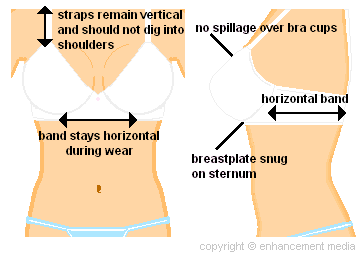Bra Sizing – Finding the Perfect Bra After Breast Lift Surgery
Shopping For Your New Bras!
Post-op bra shopping sounds exciting at first – and it is, if you have a band size of 34 or higher and a cup size of D or lower. But a lot of women with larger than average breasts and smaller than average frames report that the novelty really wears off really fast. If you are small-boned and are getting medium to large implants with your lift, you may dislike this part, although it's a lot easier now that bra companies realize they need bigger cups and smaller band sizes due to the popularity of breast implants.
You Will Lose At Least A Cup Size With Your Lift
. . . that is, if you don't get breast implants. If you don't, the skin that is removed will take away any "volume" you had in your favorite bra. So prepare your mind for it, and find solace in the fact that smaller cupped bras are plentiful and usually very pretty.
The Importance of Choosing a Proper Fitting Bra
Finding the perfect bra after your surgery isn't impossible, it may just be a little more difficult. But it is imperative to find a proper fitting bra, one that properly fits your frame and supports your breasts. If not, you will eventually have breasts that sag again, plus back aches, shoulder aches, thinning skin and other problems.
Many women believe in formulas that determine their exact bra size. While they can help start you on the right path, fit is definitely an individual matter. Your best bet is to try on a bra and wear it for a while – then you'll know if it is too large for you.
If your bra band rides up in the back, and if you find yourself trying to lift your breasts by shortening your shoulder straps, you are only doing your breasts a disservice. It' very important when buying a new bra that it should fit snugly on the last setting (the loosest hook set). This way when your bra stretches with wear you can fasten it tighter on the next two settings.
If you find that your bras bag at the nipple area postoperatively, try purchasing a bra with Lycra in the cups that will conform to the breasts. Many patients report that "natural form" bras don't fit very well, especially when there was little to no natural breast tissue preoperatively.
If you have that horrible quadruple-boob look, where you look like your breasts have been split in two and have that not so appealing double-decker appearance, you need a larger cup size.
Do your breasts fall out of your bra when you bend over? You may need more coverage.
Be sure to remeasure yourself in the event of weight gain or loss (even if only 5 to 10 pounds), pregnancy, or simply as time goes by. Measurements can vary over the years.
It is best to hand wash (or machine wash inside a lingerie bag) and line dry your bras to extend their life. The high heat of a clothes dryer will weaken elastic and ruin your bras.
Measuring for Your Band Size
To determine your band size (also called frame or back size), use a tailor's soft measuring tape (like the one pictured to the left) to measure around your ribcage. Start by wrapping the tape snugly around your ribcage, directly under your breast lobes. Be sure that the tape is horizontal and doesn't sit too low or too high around your back. Next, add 4 to the measurement if it's an even number and 5 if it's odd. For example, my ribcage measures 28 inches around. I add 4 to this measurement totaling 32.
| Frame Measurement | Add 4 if an even number, add 5 if odd | Bra Band-size |
| 23" | +5 | 28 |
| 24" | +4 | 28 |
| 25" | +5 | 30 |
| 26" | +4 | 30 |
| 27" | +5 | 32 |
| 28" | +4 | 32 |
| 29" | +5 | 34 |
| 30" | +4 | 34 |
| 31" | +5 | 36 |
| 32" | +4 | 36 |
| 33" | +5 | 38 |
| 34" | +4 | 38 |
| 35" | +5 | 40 |
| 36" | +4 | 40 |
| 37" | +5 | 42 |
| 38" | +4 | 42 |
| 39" | +5 | 44 |
| 40" | +4 | 44 |
| 41" | +5 | 46 |
| 42" | +4 | 46 |
| 43" | +5 | 48 |
| 44" | +4 | 48 |
| 45" | +5 | 50 |
| 46" | +4 | 50 |
| 47" | +5 | 52 |
| 48" | +4 | 52 |
| 49" | +5 | 54 |
| 50" | +4 | 54 |
Determining Your Cup Size
There are two common formulas to determine your approximate cup size. One way is to measure across and around your actual breasts. Some insist this must be performed while wearing a non-padded, thin fabric bra, while others advise measuring without a bra (my personal choice). If you have significant sag and redundant tissue, you will wear a larger cup size than someone who measures the same at the fullest part who has little to no ptosis. Redundant tissue still takes up mass and this mass will spill over a bra that is too small based on a measurement determined by the circumference at the fullest part of the breast. This is why it is important to use these measurements as a starting point and not a rule carved in stone.
Center the measuring tape over the fullest part of the breasts (commonly across the nipples) and around your back, making sure that it lies flat and horizontal. Determine the difference by subtracting the band size from the bust size measurement. For instance, my band size is 32 and my bust size is 37. According to the chart below, I would be a 32DD – but I spill out of the top of a 32DD, so I wear a 32DDD/F. This is what I mean about being individual and that not all formulas are going to work for everyone.
| bust-size minus band-size | = cup size |
| 0 to 1/2" | AA cup |
| 1/2" to 1" | A cup |
| 1" to 2 1/2" | B cup |
| 2 1/2" to 3 1/2" | C cup |
| 3 1/2" to 4 1/2" | D cup |
| 4 1/2" to 6" | DD (or E cup for some bras) |
| 6" to 7" | DDD (or F cup for some bras) |
| 7" to 8" | G cup |
| 8" to 9" | GG cup |
| 9" to 10" | H cup |
| 10" to 11" | HH cup |
| 11" to 12" | J cup |
| 12" to 13" | JJ cup |
Bra Straps
Bra straps should be comfortable, not dig trenches into your shoulders or irritate your skin. And they should not be used as the primary support feature for your breasts – that should be the band. Bra straps can be thin or wide, padded or not, but they should not be digging into your shoulders. If this is the case, your band size may not be snug enough to support you properly.
How Do I Know If My Bra Fits?
Comfort is important, but support is equally important. You may find that you fit perfectly in bras from Victoria's Secret, but Wacoal bras may run smaller for you. Don't be surprised when fit varies from label to label.
 |
- Is the band snug, but not so tight that it's cutting off your circulation or causing you pain?
- Is the band horizontal or does it ride up your back? If it's riding up, you need a smaller band size.
- Is the bra rubbing against or gaping away from your sternum? If it's too tight, try going up a band size. If it's too loose, try a smaller band size so that it rests firmly up against your breastbone.
- Are the bra straps digging into your shoulders? Try loosening them a bit. Support should primarily come from the band.
- Are your breasts spilling out of the cups? You need a larger cup size. Is the cup gaping? Try a smaller cup size.
Does Your Band Size Increase After Breast Augmentation?
 No, no, and no! If it did, it's because of your swelling or you gained weight during your downtime. Your band size is determined by your rib cage measurement under the breast lobe, not your cup size. Please ladies, find a bra that fits you and stick with it unless you gain weight! If you were a 34B before surgery and went up to a D cup, you are going to be a 34D, not a 36B or 36D. The only exception is if your surgeon had to significantly lower your natural breast crease and the bra band will rest a little lower on your ribcage. Usually this means a smaller band size, but the difference is minimal.
No, no, and no! If it did, it's because of your swelling or you gained weight during your downtime. Your band size is determined by your rib cage measurement under the breast lobe, not your cup size. Please ladies, find a bra that fits you and stick with it unless you gain weight! If you were a 34B before surgery and went up to a D cup, you are going to be a 34D, not a 36B or 36D. The only exception is if your surgeon had to significantly lower your natural breast crease and the bra band will rest a little lower on your ribcage. Usually this means a smaller band size, but the difference is minimal.
Sleep Bras and Support Garments for Sleeping
I personally wear a bra to sleep every night. It is so much more comfortable for me because I have rather large implants for my frame. I find that standard sports bras push my implants into my armpits, but cupped models or regular bras keep them where they belong, on my chest. However, regular bras are not comfortable to sleep in because they're not designed for sleep. A good sleep bra should be supportive, yet sturdy and comfortable. I don't want to ruin my breast lift, so I wear a supportive bra every night and most of my waking moments as well. Most sleep bras are soft cups with no underwire – very comfortable and a refreshing change if you wear underwire by day. I choose Design Veronique because they have very high quality support garments and sleep bras. These garments are designed for comfort and to last.
Online Bra Distribution
Here are some links to companies that sell bras in larger cup sizes with hard-to-find smaller band sizes. These sites also carry more common bra sizes as well. Remember, it's important to have the correct band size that fits snugly under your breasts and around your ribcage and doesn't ride up your back. If you don't, you'll be spending even more money getting a breast lift. All breasts need support.
